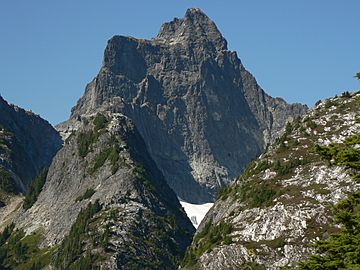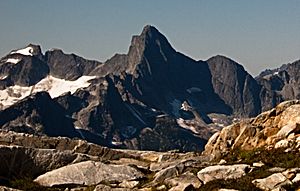Mount Triumph facts for kids
Quick facts for kids Mount Triumph |
|
|---|---|

The east face of Mount Triumph (center skyline)
|
|
| Highest point | |
| Elevation | 7240+ ft (2207+ m) NGVD 29 |
| Prominence | 1,720 ft (524 m) |
| Geography | |
| Parent range | Cascade Range |
| Topo map | USGS Mount Blum |
| Climbing | |
| First ascent | July 31, 1938 by Lloyd Anderson, Lyman Boyer, Dave Lind, Sig Hall, and Louis Smith |
| Easiest route | Rock/ice climb |
Mount Triumph is a tall mountain peak in the North Cascades mountain range. This range is located in Washington state, U.S.. The mountain is about 5.5 miles (8.8 km) northwest of the town of Newhalem. Lage Wernstedt, a surveyor, gave it its name.
Mount Triumph is a very important peak in North Cascades National Park. Many people consider it one of the park's most amazing sights. It is famous among climbers because it does not have any easy ways to reach the top. Even though it's not the highest mountain, it rises very steeply from the ground around it. For example, it climbs 1 mile (1.6 km) in less than 2 miles (3.2 km) on its east side.
The mountain looks very rough and rugged. One writer described it as a "rock thumb" with sides that are almost straight up. Some parts even hang over! From above, it looks like a three-bladed propeller. This shape comes from its northeast, northwest, and south ridges. Another mountain, Mount Despair, is about 2.3 miles (3.7 km) to the north-northwest. These two peaks are connected by a lower area called Triumph Pass.
Mountain Geology and Features
Mount Triumph is part of the land that drains into the Skagit River. Bacon Creek and Goodell Creek, which flow near the mountain, are smaller streams that feed into the Skagit River. You can find two small glaciers below the east and north sides of the mountain. These glaciers are getting smaller over time.
The south ridge of Mount Triumph ends at a smaller peak called Thornton Peak. On its south side, there's a deep bowl-shaped area called a cirque. This cirque holds the Thornton Lakes, which are three lakes found at different heights. These lakes are the source of Thornton Creek, another stream that flows into the Skagit River.
The rocks of Mount Triumph are made of very old orthogneiss. This is a type of rock that has been changed by heat and pressure. Nearby Mount Despair is made of a light gray rock called granodiorite. This rock is part of a very large body of rock called the Chilliwack batholith. East of the Thornton Lakes, you can see dark rocks like amphibolite and schist.
Climbing Mount Triumph
The easiest way to climb to the top of Mount Triumph is from the west side. This route is rated as Class 4, which means it involves some difficult climbing. It can be dangerous if the rocks are wet. Climbers usually start this route from Triumph Pass.
The northeast ridge offers a more challenging climb, rated as Class 5.5. This means it requires special climbing skills and equipment. However, climbers often enjoy this route because the rock is generally good for climbing. You can reach this route by using the Thornton Lakes Trail.
There's also a simpler climbing route, called a scrambling route, from the Thornton Lakes Trail. This route leads to the top of Trappers Peak. From Trappers Peak, you can get great views of Mount Triumph.
Mountain Climate
Mount Triumph is in a marine west coast climate zone. This means it gets a lot of moisture from the Pacific Ocean. Most weather fronts, which are like big weather systems, come from the Pacific Ocean. They then travel northeast towards the Cascade Mountains.
When these weather fronts reach the North Cascades, the tall mountains force the air to rise. As the air goes up, it cools down and drops its moisture. This process is called Orographic lift. Because of this, the western side of the North Cascades gets a lot of rain or snow.
During the winter, the weather is usually cloudy. However, in the summer, high-pressure systems over the Pacific Ocean often bring clear skies. Because the climate is influenced by the ocean, the snow tends to be wet and heavy. This can create a high risk of avalanches, which are dangerous slides of snow down the mountain.
Nearby Mountains





